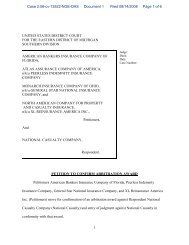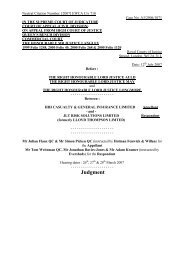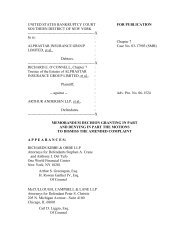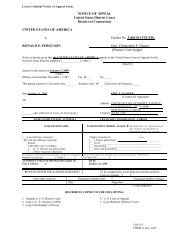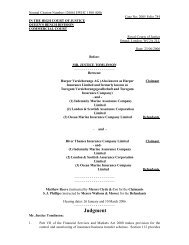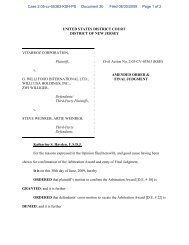Statutory Issue Paper No62R - Reinsurance Focus
Statutory Issue Paper No62R - Reinsurance Focus
Statutory Issue Paper No62R - Reinsurance Focus
Create successful ePaper yourself
Turn your PDF publications into a flip-book with our unique Google optimized e-Paper software.
Property and Casualty <strong>Reinsurance</strong><br />
SSAP No. 62R<br />
5. Q: Prospective and retroactive portions of a reinsurance contract are allowed to be accounted<br />
for separately, if practicable. Can the retroactive portion of an existing contract be<br />
segregated and, therefore, exempted with other retroactive contracts covering insured<br />
events occurring prior to January 1, 1994?<br />
A: No. The transition provisions apply to an entire contract, which is either subject to or<br />
exempt from the revised provisions of SSAP No. 62. A ceding entity may bifurcate a<br />
contract already subject to the new accounting rules in SSAP No. 62 and then account for<br />
both the prospective and retroactive portions in accordance with the new accounting<br />
standard.<br />
Risk Transfer<br />
6. Q: Do the new risk transfer provisions apply to existing contracts?<br />
A: Yes, the new risk transfer provisions apply to some existing contracts. SSAP No. 62<br />
applies in its entirety only to existing contracts which were renewed or amended on or<br />
after January 1, 1994, or which cover losses occurring or claims made after that date.<br />
Therefore, those contracts must be evaluated to determine whether they transfer risk and<br />
qualify for reinsurance accounting. For accounting periods commencing on or after<br />
January 1, 1995, balances relating to such contracts which do not transfer insurance risk<br />
shall be reclassified as deposits and shall be accounted for and reported in the manner<br />
described under the caption <strong>Reinsurance</strong> Contracts Must Include Transfer of Risk.<br />
SSAP No. 62 does not apply to existing contracts which were entered into before, and<br />
were not renewed or amended on or after, January 1, 1994, and which cover only losses<br />
occurring or claims made before that date, nor to contracts which expired before, and<br />
were not renewed or amended on or after, January 1, 1995. Those contracts will continue<br />
to be accounted for in the manner provided by SSAP No. 62 before these revisions.<br />
7. Q: How does the effective date affect the assessment of whether a significant loss to the<br />
reinsurer was reasonably possible?<br />
A: The risk transfer assessment is made at contract inception, based on facts and<br />
circumstances known at the time. Because that point in time has passed for existing<br />
contracts, some have suggested that the risk transfer provisions be applied as of the<br />
effective date. However, that approach to the risk transfer assessment would violate the<br />
requirement to consider all cash flows from the contract. Therefore, the test must be<br />
applied from contract inception, considering the effect of any subsequent contract<br />
amendments. Careful evaluation and considered judgment will be required to determine<br />
whether a significant loss to the reinsurer was reasonably possible at inception.<br />
8. Q: Should risk transfer be reassessed if contractual terms are subsequently amended?<br />
A: Yes. When contractual terms are amended, risk transfer should be reassessed. For<br />
example, a contract that upon inception met the conditions for reinsurance accounting<br />
could later be amended so that it no longer meets those conditions. The contract should<br />
then be reclassified and accounted for as a deposit.<br />
9. Q: How should the risk transfer assessment be made when a contract has been amended?<br />
© 2009 National Association of Insurance Commissioners 62-25


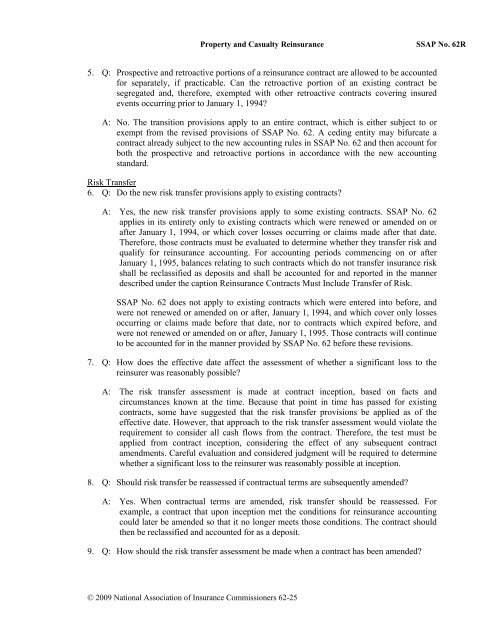
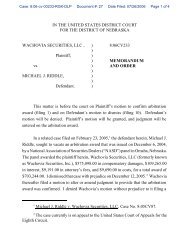
![202 Folio No 734 Neutral Citation Number: [2006] EWHC 1345 (QB ...](https://img.yumpu.com/50015000/1/184x260/202-folio-no-734-neutral-citation-number-2006-ewhc-1345-qb-.jpg?quality=85)
